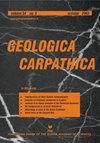Carboniferous mafic metavolcanic rocks in the Northern Gemeric Unit: Petrogenesis, geochemistry, isotope composition and tectonic implication
IF 1.5
4区 地球科学
Q4 GEOSCIENCES, MULTIDISCIPLINARY
引用次数: 2
Abstract
The paper presents whole rock chemical composition and Sr–Nd isotope data from selected metabasic rocks from the Mississippian and Pennsylvanian sequences of the Northern Gemeric Unit. The analysed metabasic rocks belong to the subalkaline magmatic series with Nb/Y ratios ranging from 0.03 to 0.21. They fit into the low-Ti tholeiitic series, characterized by TiO2 contents of less than 2.5 wt. % and Ti/Y ratios below 500. Petrological and chemical signatures show the separation of the Group I (Pennsylvanian) from the Group II (Mississippian) metabasalts, which is supported by biostratigraphical data of the surrounding metasediments. The Group I metabasalts display higher contents of Zr, Th, Rb and U, Pb, Zn, Ni compared to the metabasalts of Group II and conversely lower contents of Nb, Ta and V. The chondrite normalized rare earth elements curves show a uniform pattern, with rare earth element enrichment and no or weak positive or negative Eu anomalies (0.88–1.23 vs. 0.89–1.17). The (Tb/Yb)N ratios from 1.36–1.62 in the Group I or 0.92–1.55 in Group II are symptomatic of spinel-bearing peridotite mantle source. Based on trace and rare earth element distribution patterns, the Group I metabasites correspond to the N-MORB/E-MORB field and the Group II metabasites shift significantly towards the BABB and CAB fields. The Sr/Nd isotope systematics confirmed depleted mantle isotopic signatures, with minor influences from crustal sources and affected by fluid-related subduction metasomatism. All the studied samples have positive εNd(0) ranging from 7.92 to 8.68 for Group I and from 4.59 to 10.52 for Group II metabasalts. The Sr/Sr(0) values vary between 0.7053–0.7081 and between 0.7052–0.7076, respectively, and 0.7109 for basaltic andesite.北成因单元石炭系基性变质火山岩:岩石成因、地球化学、同位素组成及其构造意义
本文介绍了北成因单元密西西比系和宾夕法尼亚系部分变质基性岩的全岩化学成分和Sr-Nd同位素数据。分析的变质岩属亚碱性岩浆岩系,Nb/Y比值为0.03 ~ 0.21。它们属于低钛拉斑岩系列,其特征是TiO2含量低于2.5 wt. %, Ti/Y比低于500。岩石学和化学特征表明,第一类(宾夕法尼亚系)变质岩与第二类(密西西比系)变质岩分离,并得到了周围变质岩生物地层资料的支持。第一类变质玄武岩的Zr、Th、Rb、U、Pb、Zn、Ni含量高于第一类变质玄武岩,而Nb、Ta、v含量低于第一类变质玄武岩。球粒陨石正态化稀土元素曲线呈现均匀分布,稀土元素富集,Eu无或弱正、负异常(0.88 ~ 1.23 vs. 0.89 ~ 1.17)。ⅰ组(Tb/Yb)N比值为1.36 ~ 1.62,ⅱ组(Tb/Yb)N比值为0.92 ~ 1.55,为含尖晶石橄榄岩幔源特征。根据微量元素和稀土元素的分布模式,第一类变质岩对应于N-MORB/E-MORB场,而第二类变质岩明显向BABB和CAB场偏移。Sr/Nd同位素系统证实了贫地幔同位素特征,地壳来源的影响较小,受流体相关俯冲交代作用的影响。ⅰ类变质岩的εNd(0)值为7.92 ~ 8.68,ⅱ类变质岩的εNd(0)值为4.59 ~ 10.52。玄武安山岩Sr/Sr(0)值分别为0.7053 ~ 0.7081、0.7052 ~ 0.7076和0.7109。
本文章由计算机程序翻译,如有差异,请以英文原文为准。
求助全文
约1分钟内获得全文
求助全文
来源期刊

Geologica Carpathica
地学-地球科学综合
CiteScore
2.40
自引率
23.10%
发文量
26
审稿时长
>12 weeks
期刊介绍:
GEOLOGICA CARPATHICA covers a wide spectrum of geological disciplines including geodynamics, tectonics and structural geology, volcanology, stratigraphy, geochronology and isotopic geology, karstology, geochemistry, mineralogy, petrology, lithology and sedimentology, paleogeography, paleoecology, paleobiology and paleontology, paleomagnetism, magnetostratigraphy and other branches of applied geophysics, economic and environmental geology, experimental and theoretical geoscientific studies. Geologica Carpathica , with its 60 year old tradition, presents high-quality research papers devoted to all aspects not only of the Alpine-Carpathian-Balkanian geoscience but also with adjacent regions originated from the Mediterranean Tethys and its continental foreland. Geologica Carpathica is an Official Journal of the Carpathian-Balkan Geological Association.
 求助内容:
求助内容: 应助结果提醒方式:
应助结果提醒方式:


